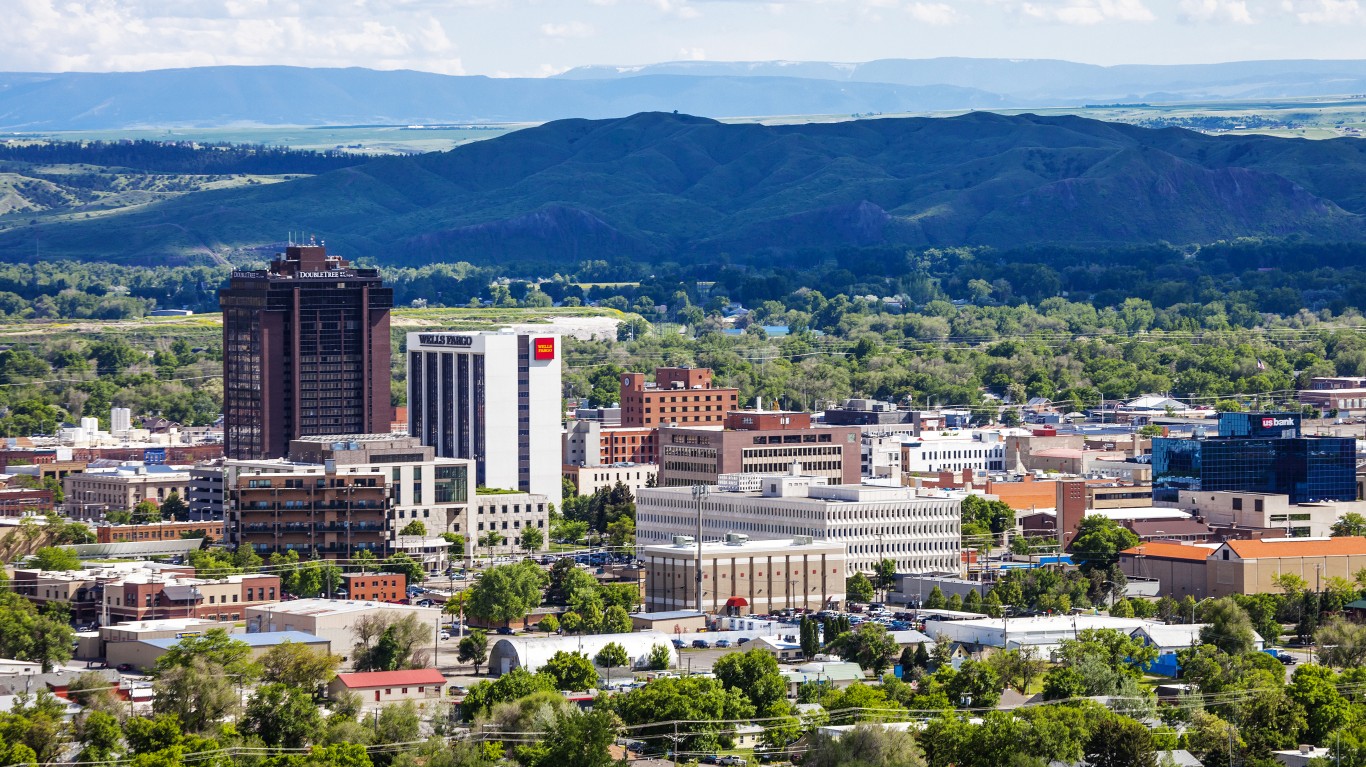Special Report
This Is the State Where the Most People Are Worried About Pay Cuts

Published:
Last Updated:

The COVID-19 pandemic savaged the job market early in 2020 and has only rebounded moderately by year-end. After crashing from a five-decade best national jobless rate of 3.5% in February to a multi decade high of 14.7% in April, the figure settled at 6.7% in December. Based on the country’s jobless rate over the last five years, the December figure is still high. The total number of people unemployed in December was 10.73 million compared to 5.84 million in December 2019.
Job loss is not the only anxiety that faces many American workers. Pay cuts are another. The United States Census Bureau has kept track of the effects of the pandemic on many aspects of American lives. The new research that tracks this is called The Household Pulse Survey. This new study, the Census says, is “designed to deploy quickly and efficiently, collecting data on a range of ways in which people’s lives have been impacted by the pandemic. Data will be disseminated in near real-time to inform federal and state response and recovery planning.”
The issues tracked range from whether people have been vaccinated, to whether people can afford food, to the likelihood people face eviction. Another specific question is the percent of adults, people who are 18 years of age or older, who believe someone in their household will have a loss of employment income in the next four weeks.
California is the state where the most people are worried about cuts in income. The figure is over 11.4 million adults. That is over 39% of the state’s population which is also the highest number among all states. 24/7 Wall St. has looked at the same data for each of the other states.
The Household Pulse Survey data has been collected each week for the last 22 weeks. The most recent statistics cover January 6 to January 18.
As is the case with unemployment and median income, concerns about wage loss vary considerably by state and city. Across the adult population of people 18 years or older, which numbers 249,170,917, 27% believe that someone in their household will have a loss of income in the next four weeks. Among the 50 states, the figure is as high as 40% in some cases, and below 20% in others.
24/7 Wall St. looked at the percent of people who “expect someone in their household to have a loss in employment income in the next 4 weeks” to create a list of states where people are most worried about pay cuts.
For each state, we have provided the total population of people over 18, the total among those who expect loss in unemployment income, and the percent of the adult population that expectation.
Click here to see the state where the most people are worried about pay cuts.

50. Vermont
> Adult population: 478,638
> Adults who expect imminent loss of income: 99,528
> Share of adults with that expectation: 20.8% (14th lowest)
[in-text-ad]

49. Wyoming
> Adult population: 424,025
> Adults who expect imminent loss of income: 108,458
> Share of adults with that expectation: 25.6% (17th highest)

48. North Dakota
> Adult population: 544,787
> Adults who expect imminent loss of income: 114,201
> Share of adults with that expectation: 21.0% (16th lowest)

47. Alaska
> Adult population: 516,286
> Adults who expect imminent loss of income: 119,327
> Share of adults with that expectation: 23.1% (22nd lowest)
[in-text-ad-2]

46. South Dakota
> Adult population: 635,126
> Adults who expect imminent loss of income: 121,754
> Share of adults with that expectation: 19.2% (9th lowest)

45. Delaware
> Adult population: 744,715
> Adults who expect imminent loss of income: 144,026
> Share of adults with that expectation: 19.3% (10th lowest)
[in-text-ad]

44. Montana
> Adult population: 818,780
> Adults who expect imminent loss of income: 157,252
> Share of adults with that expectation: 19.2% (9th lowest)

43. New Hampshire
> Adult population: 1,067,065
> Adults who expect imminent loss of income: 211,625
> Share of adults with that expectation: 19.8% (12th lowest)

42. Rhode Island
> Adult population: 805,025
> Adults who expect imminent loss of income: 218,929
> Share of adults with that expectation: 27.2% (10th highest)
[in-text-ad-2]

41. Maine
> Adult population: 1,036,592
> Adults who expect imminent loss of income: 223,939
> Share of adults with that expectation: 21.6% (18th lowest)

40. Nebraska
> Adult population: 1,375,250
> Adults who expect imminent loss of income: 239,248
> Share of adults with that expectation: 17.4% (3rd lowest)
[in-text-ad]

39. Idaho
> Adult population: 1,315,557
> Adults who expect imminent loss of income: 258,265
> Share of adults with that expectation: 19.6% (11th lowest)

38. West Virginia
> Adult population: 1,359,224
> Adults who expect imminent loss of income: 334,558
> Share of adults with that expectation: 24.6% (22nd highest)

37. Utah
> Adult population: 2,249,226
> Adults who expect imminent loss of income: 346,948
> Share of adults with that expectation: 15.4% (the lowest)
[in-text-ad-2]

36. Kansas
> Adult population: 2,109,554
> Adults who expect imminent loss of income: 398,258
> Share of adults with that expectation: 18.9% (7th lowest)

35. Hawaii
> Adult population: 1,064,291
> Adults who expect imminent loss of income: 400,988
> Share of adults with that expectation: 37.7% (2nd highest)
[in-text-ad]

34. New Mexico
> Adult population: 1,562,954
> Adults who expect imminent loss of income: 422,414
> Share of adults with that expectation: 27.0% (12th highest)

33. Iowa
> Adult population: 2,327,313
> Adults who expect imminent loss of income: 428,997
> Share of adults with that expectation: 18.4% (6th lowest)

32. Arkansas
> Adult population: 2,156,304
> Adults who expect imminent loss of income: 491,167
> Share of adults with that expectation: 22.8% (21st lowest)
[in-text-ad-2]

31. Kentucky
> Adult population: 3,267,528
> Adults who expect imminent loss of income: 571,068
> Share of adults with that expectation: 17.5% (4th lowest)

30. Mississippi
> Adult population: 2,171,424
> Adults who expect imminent loss of income: 574,615
> Share of adults with that expectation: 26.5% (14th highest)
[in-text-ad]

29. Connecticut
> Adult population: 2,699,637
> Adults who expect imminent loss of income: 644,175
> Share of adults with that expectation: 23.9% (25th highest)

28. Oklahoma
> Adult population: 2,860,129
> Adults who expect imminent loss of income: 721,668
> Share of adults with that expectation: 25.2% (21st highest)

27. Missouri
> Adult population: 4,539,396
> Adults who expect imminent loss of income: 774,873
> Share of adults with that expectation: 17.1% (2nd lowest)
[in-text-ad-2]

26. Alabama
> Adult population: 3,587,733
> Adults who expect imminent loss of income: 786,021
> Share of adults with that expectation: 21.9% (20th lowest)

25. Wisconsin
> Adult population: 4,389,691
> Adults who expect imminent loss of income: 790,985
> Share of adults with that expectation: 18.0% (5th lowest)
[in-text-ad]

24. Oregon
> Adult population: 3,240,258
> Adults who expect imminent loss of income: 825,683
> Share of adults with that expectation: 25.5% (19th highest)

23. Nevada
> Adult population: 2,372,430
> Adults who expect imminent loss of income: 876,886
> Share of adults with that expectation: 37.0% (3rd highest)

22. Minnesota
> Adult population: 4,193,101
> Adults who expect imminent loss of income: 879,576
> Share of adults with that expectation: 21.0% (16th lowest)
[in-text-ad-2]

21. South Carolina
> Adult population: 3,908,361
> Adults who expect imminent loss of income: 988,680
> Share of adults with that expectation: 25.3% (20th highest)
20. Louisiana
> Adult population: 3,371,767
> Adults who expect imminent loss of income: 989,026
> Share of adults with that expectation: 29.3% (7th highest)
[in-text-ad]

19. Indiana
> Adult population: 4,923,570
> Adults who expect imminent loss of income: 1,016,819
> Share of adults with that expectation: 20.7% (13th lowest)

18. Colorado
> Adult population: 4,400,803
> Adults who expect imminent loss of income: 1,081,546
> Share of adults with that expectation: 24.6% (22nd highest)

17. Maryland
> Adult population: 4,542,750
> Adults who expect imminent loss of income: 1,099,520
> Share of adults with that expectation: 24.2% (24th highest)
[in-text-ad-2]

16. Tennessee
> Adult population: 5,111,833
> Adults who expect imminent loss of income: 1,105,279
> Share of adults with that expectation: 21.6% (18th lowest)

15. Virginia
> Adult population: 6,338,699
> Adults who expect imminent loss of income: 1,378,614
> Share of adults with that expectation: 21.7% (19th lowest)
[in-text-ad]

14. Massachusetts
> Adult population: 5,232,521
> Adults who expect imminent loss of income: 1,393,551
> Share of adults with that expectation: 26.6% (13th highest)

13. Washington
> Adult population: 5,845,136
> Adults who expect imminent loss of income: 1,535,298
> Share of adults with that expectation: 26.3% (15th highest)

12. Arizona
> Adult population: 5,506,736
> Adults who expect imminent loss of income: 1,555,040
> Share of adults with that expectation: 28.2% (8th highest)
[in-text-ad-2]

11. New Jersey
> Adult population: 6,628,300
> Adults who expect imminent loss of income: 1,693,816
> Share of adults with that expectation: 25.6% (17th highest)

10. Ohio
> Adult population: 8,660,644
> Adults who expect imminent loss of income: 2,031,543
> Share of adults with that expectation: 23.5% (25th lowest)
[in-text-ad]

9. Michigan
> Adult population: 7,502,600
> Adults who expect imminent loss of income: 2,049,659
> Share of adults with that expectation: 27.3% (9th highest)

8. North Carolina
> Adult population: 7,915,998
> Adults who expect imminent loss of income: 2,142,676
> Share of adults with that expectation: 27.1% (11th highest)

7. Illinois
> Adult population: 9,449,378
> Adults who expect imminent loss of income: 2,195,841
> Share of adults with that expectation: 23.2% (23rd lowest)
[in-text-ad-2]

6. Pennsylvania
> Adult population: 9,625,216
> Adults who expect imminent loss of income: 2,243,043
> Share of adults with that expectation: 23.3% (24th lowest)

5. Georgia
> Adult population: 7,836,467
> Adults who expect imminent loss of income: 2,551,255
> Share of adults with that expectation: 32.6% (4th highest)
[in-text-ad]

4. Florida
> Adult population: 16,734,221
> Adults who expect imminent loss of income: 4,314,334
> Share of adults with that expectation: 25.8% (16th highest)

3. New York
> Adult population: 14,582,179
> Adults who expect imminent loss of income: 4,636,737
> Share of adults with that expectation: 31.8% (5th highest)

2. Texas
> Adult population: 20,970,310
> Adults who expect imminent loss of income: 6,179,653
> Share of adults with that expectation: 29.5% (6th highest)
[in-text-ad-2]

1. California
> Adult population: 29,167,627
> Adults who expect imminent loss of income: 11,492,552
> Share of adults with that expectation: 39.4% (the highest)
After two decades of reviewing financial products I haven’t seen anything like this. Credit card companies are at war, handing out free rewards and benefits to win the best customers.
A good cash back card can be worth thousands of dollars a year in free money, not to mention other perks like travel, insurance, and access to fancy lounges.
Our top pick today pays up to 5% cash back, a $200 bonus on top, and $0 annual fee. Click here to apply before they stop offering rewards this generous.
Flywheel Publishing has partnered with CardRatings for our coverage of credit card products. Flywheel Publishing and CardRatings may receive a commission from card issuers.
Thank you for reading! Have some feedback for us?
Contact the 24/7 Wall St. editorial team.